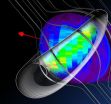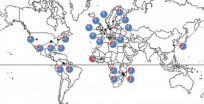(Press-News.org) This news release is available in German.
Spinach looks nothing like parsley, and basil bears no resemblance to thyme. Each plant has a typical leaf shape that can differ even within the same family. The information about what shape leaves will be is stored in the DNA. According to researchers at the Max Planck Institute for Plant Breeding Research in Cologne, the hairy bittercress (Cardamine hirsuta) has a particular gene to thank for its dissected leaves. This homeobox gene inhibits cell proliferation and growth between leaflets, allowing them to separate from each other. The thale cress Arabidopsis thaliana does not have this gene. Therefore, its leaves are not dissected, but simple and entire.
Miltos Tsiantis and his colleagues at the Max Planck Institute for Plant Breeding Research in Cologne discovered the new gene when comparing two plants from the Brassicaceae family: Cardamine hirsuta has dissected leaves that form leaflets and Arabidopsis thaliana has simple leaves. The researchers identified the RCO (REDUCED COMPLEXITY) gene, which makes leaves of the hairy bittercress more complex. Arabidopsis lacks this gene and, accordingly, lacks leaflets. RCO is only active in growing leaves. RCO ensures that cell proliferation and growth is prevented in areas of the leaf margin between sites of leaflet formation. "The leaves of Arabidopsis are simple and entire because growth is not inhibited by the RCO gene," explains Tsiantis. "If we had not compared the two plants we would never have discovered this difference, as it is impossible to find a gene where none exists," he adds.
The scientists first identified the RCO gene through a mutation in the hairy bittercress. In the absence of functional RCO the hairy bittercress can no longer produces leaflets. The RCO gene belongs to a cluster of three genes, which arose during evolution through the duplication of a single gene. In the thale cress, the original triple cluster now consists of a single gene. When the scientists return the RCO gene to the thale cress in the laboratory, evolution is partially reversed. "The simple oval leaves of Arabidopsis now develop deep lobes" says Tsiantis, "The fact that the leaf shape becomes complex again through the transfer of the RCO gene alone, shows that most of the apparatus for the formation of leaflets must still be present in the thale cress and was not lost with the RCO gene."
The research team also examined the RCO sequence in greater detail and found it is a Homeobox gene. These genes function like genetic switches in that they activate or deactivate other genes. The scientists also demonstrated that RCO function is restricted to leaf shape; it does not decide whether leaves actually form. The loss of the RCO gene does not give rise to any other visible changes in the hairy bittercress. Therefore, its effect is limited to the inhibition of growth on the leaf margin. RCO does not work with the plant hormone auxin here. This specificity makes RCO a more likely driver of leaf shape evolution than any other genes identified to date. Tsiantis and his colleagues aim to decode its exact functionality in the months to come.
The scientists also examined the two genes which form a cluster with RCO and which arose in the course of evolution through the duplication of a precursor gene. They wanted to find out how the novel function of RCO in promoting leaf complexity arose. Apparently, the main functional difference lies in the control regions of the genes and not in the protein sequences. The control regions dictate when and how the relevant gene is read. If one or other of the two genes is subjected to the effect of the RCO control region, Arabidopsis makes complex leaves. Thus, the dissected leaves of the hairy bittercress are primarily owed to the control region of the RCO gene.
INFORMATION:
Original publication:
Daniela Vlad et al.
Leaf Shape Evolution Through Duplication, Regulatory Diversification, and Loss of a Homeobox Gene.
Science, February 14, 2014 (DOI: 10.1126/science.1248384)
Gene for dissected leaves
Arabidopsis thaliana lost the RCO gene over the course of evolution and thus forms simple leaves
2014-02-14
ELSE PRESS RELEASES FROM THIS DATE:
Our brain has switch board to guide behavior in response to external stimuli
2014-02-14
How do our brains combine information from the external world (sensory stimulation) with information on our internal state such as hunger, fear or stress? NERF-scientists demonstrate that the habenula, a specific part in our brain consisting of neural circuits, acts as a gate for sensory information, thus regulating behavior in response to external stimuli.
Emre Yaksi (NERF – VIB/imec/KU Leuven): "Our brain has high levels of spontaneous activity, even in the absence of sensory stimulation. We think that this spontaneous neural activity in combination with sensory stimulation ...
Inside out at the 2014 AAAS meeting: The impact of gut flora on diabetes and obesity
2014-02-14
In recent years, the 1.5 kilos of bacteria that live inside our bodies, mainly in the gut, have proven their crucial importance for our healthy functioning. Beyond their more obvious role in digestion, they are also involved, for example, in the development of the immune system and the neuronal system, and in the onset of certain diseases.
Three leading European researchers on the gut microbiome will share their recent findings on the relations between gut flora and obesity, diabetes, and cardio-metabolic diseases in general.
Links Between Human Gut Microbiota and Metabolic ...
NASA's IBEX helps paint picture of the magnetic system beyond the solar wind
2014-02-14
Understanding the region of interstellar space through which the solar system travels is no easy task. Interstellar space begins beyond the heliosphere, the bubble of charged particles surrounding the sun that reaches far beyond the outer planets. Voyager 1 has crossed into this space, but it's difficult to gain a complete global picture from measurements in only one direction.
Spacecraft data in the past five years from near Earth and cosmic ray observations have painted a better picture of the magnetic system that surrounds us, while at the same time raising new questions. ...
Impaired recovery from inflammation linked to Alzheimer's
2014-02-14
New research from Karolinska Institutet in Sweden shows that the final stage of the normal inflammatory process may be disrupted in patients with Alzheimer's disease. A study published in the journal Alzheimer's & Dementia shows that levels in the brain and cerebrospinal fluid of the molecules necessary for tissue recovery through the clearance of harmful inflammatory substances are lower than normal in patients with Alzheimer's disease. The study also showed association between the lower levels of these molecules with impaired memory function.
Alzheimer's disease is ...
Social norms strongly influence vaccination decisions and the spread of disease
2014-02-14
Our response to societal pressures about vaccination has a direct effect on the spread of pediatric infectious diseases in areas where inoculation is not mandatory, says new research published this week in Proceedings of the Royal Society B.
By incorporating social norms into predictive mathematical modelling, a research team from the University of Guelph and the University of Waterloo found that they can foresee the observed patterns of population behaviour and disease spread during vaccine scares—times when anti-vaccine sentiment is strong.
"If vaccination is not ...
New insight into protein misfolding in neurodegenerative disorders
2014-02-14
Research by the University of Southampton has provided new insight into the consequence of accumulated 'misfolded proteins' in neurodegenerative disorders, such as Prion and Alzheimer's disease.
Prion and Alzheimer's disease are protein misfolding brain diseases, where genetic mutations, or more commonly, interactions between an individual's genetics and environmental influences cause functional proteins in neurons to become misfolded or misrouted. In these diseases, there is a progressive death of nerve cells in specific brain regions, which is associated with the increasing ...
Geographical passwords worth their salt
2014-02-14
It's much easier to remember a place you have visited than a long, complicated password, which is why computer scientist Ziyad Al-Salloum of ZSS-Research in Ras Al Khaimah, UAE, is developing a system he calls geographical passwords.
Writing in a freely available "open access" research paper in the International Journal of Security and Networks, Al-Salloum emphasizes how increasingly complicated our online lives are becoming with more and more accounts requiring more and more passwords. Moreover, he adds that even strong, but conventional passwords are a security risk ...
Antimicrobial preservation strategies to prevent food contamination
2014-02-14
New Rochelle, NY, February 13, 2014—Food spoiling and poisoning caused by microbial contamination can cause major health, social, and economic problems. The broad scope of antimicrobial approaches to kill or prevent the growth of microorganisms in foods and beverages, including a variety of natural and artificial preservative strategies, are described in a comprehensive Review article in Industrial Biotechnology, a peer-reviewed journal from Mary Ann Liebert, Inc., publishers. The article is available on the Industrial Biotechnology website.
In the Review "Ingredient ...
New depression treatments reported
2014-02-14
MAYWOOD, IL – New insights into the physiological causes of depression are leading to treatments beyond common antidepressants such as Prozac and Zoloft, researchers are reporting in the in the journal Current Psychiatry.
Depression treatments on the horizon include new medications, electrical and magnetic stimulation of the brain and long-term cognitive behavioral therapy for stress management.
Authors are Murali Rao, MD, and Julie M. Alderson, DO. Rao is professor and chair of the Department of Psychiatry and Behavioral Neurosciences at Loyola University Chicago ...
Geographic variation of human gut microbes tied to obesity
2014-02-14
People living in cold, northern latitudes have bacteria in their guts that may predispose them to obesity, according to a new study by researchers at the University of California, Berkeley, and the University of Arizona, Tucson.
The researchers' analysis of the gut microbes of more than a thousand people from around the world showed that those living in northern latitudes had more gut bacteria that have been linked to obesity than did people living farther south.
The meta-analysis of six earlier studies by UC Berkeley graduate student Taichi Suzuki and evolutionary ...
LAST 30 PRESS RELEASES:
New microfluidics technology enables highly uniform DNA condensate formation
A new strategy for immune tolerance
Super Mario Bros. help fight burnout: New study links classic games to boosted happiness
Deepest gas hydrate cold seep ever discovered in the arctic: International research team unveils Freya Hydrate Mounds at 3,640 m depth.
Integrating light and structure: Smarter mapping for fragile wetland ecosystems
ACA-SIM: A robust way to decode satellite signals over complex waters
Probiotics can restore gut microbiome in breastfed infants
AI could help predict nutrition risks in ICU patients, study finds
Federal EITC has unexpected result, researchers say – it decreases domestic violence
Researchers identify gene that calms the mind and improves attention in mice
Artificial metabolism turns waste CO2 into useful chemicals
Ancient sea anemone sheds light on animal cell type evolution
Begging gene leads to drone food
How climate policies that incentivize and penalize can drive the clean energy transition
Can community awareness campaigns in low-resource areas improve early diagnosis of colorectal cancer?
Stardust study resets how life’s atoms spread through space
Practical education: Clinical scenario-based program development
The impact of family dynamics on eating behaviour – how going home for Christmas can change how you eat
Tracing the quick synthesis of an industrially important catalyst
New software sheds light on cancer’s hidden genetic networks
UT Health San Antonio awarded $3 million in CPRIT grants to bolster cancer research and prevention efforts in South Texas
Third symposium spotlights global challenge of new contaminants in China’s fight against pollution
From straw to soil harmony: International team reveals how biochar supercharges carbon-smart farming
Myeloma: How AI is redrawing the map of cancer care
Manhattan E. Charurat, Ph.D., MHS invested as the Homer and Martha Gudelsky Distinguished Professor in Medicine at the University of Maryland School of Medicine
Insilico Medicine’s Pharma.AI Q4 Winter Launch Recap: Revolutionizing drug discovery with cutting-edge AI innovations, accelerating the path to pharmaceutical superintelligence
Nanoplastics have diet-dependent impacts on digestive system health
Brain neuron death occurs throughout life and increases with age, a natural human protein drug may halt neuron death in Alzheimer’s disease
SPIE and CLP announce the recipients of the 2025 Advanced Photonics Young Innovator Award
Lessons from the Caldor Fire’s Christmas Valley ‘Miracle’
[Press-News.org] Gene for dissected leavesArabidopsis thaliana lost the RCO gene over the course of evolution and thus forms simple leaves





